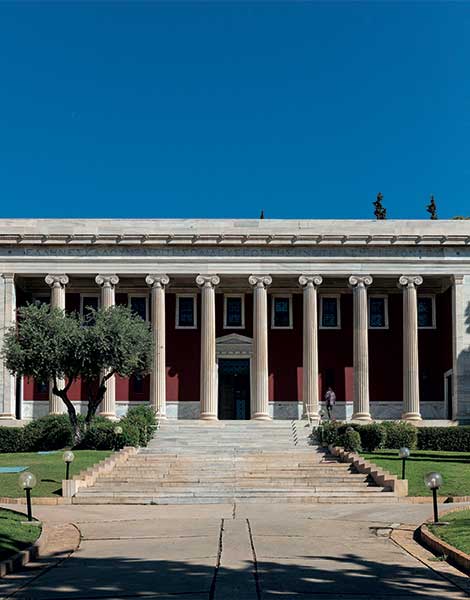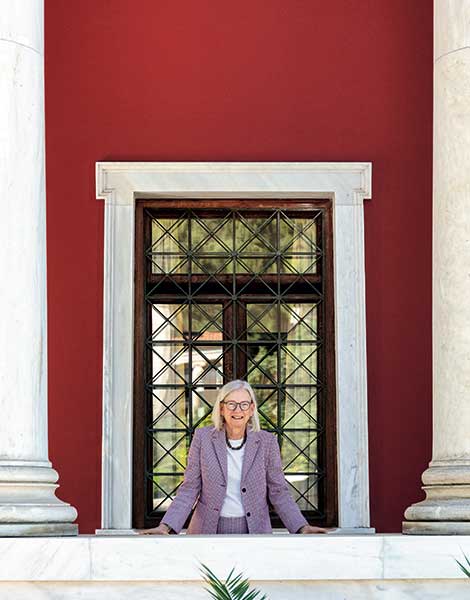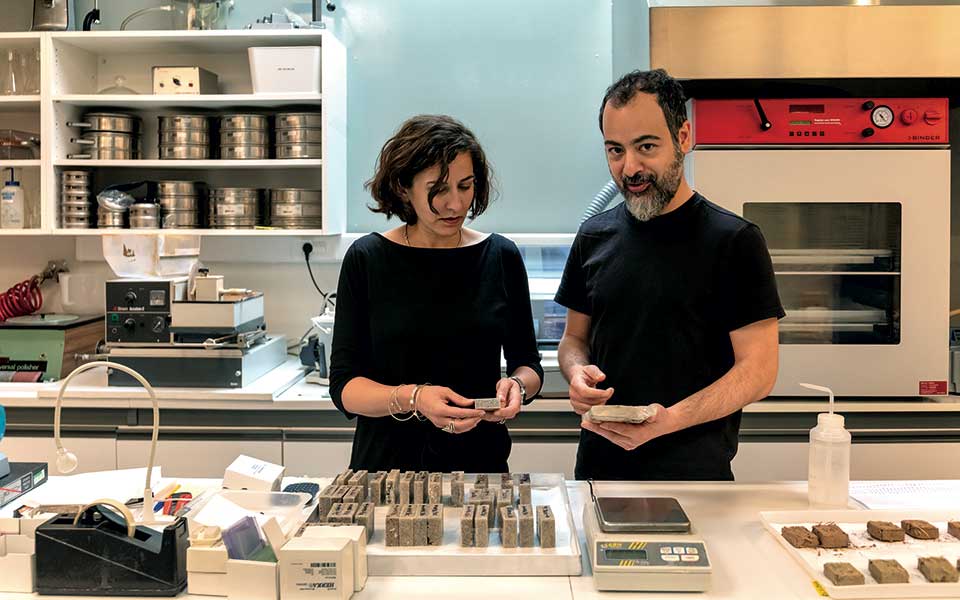Professor Bonna Wescoat, director of the American School of Classical Studies at Athens (ASCSA), works from an office within a complex of buildings filled with books, research laboratories, and exhibition halls, all surrounded by the beautiful, well-kept gardens of the enviably verdant ASCSA campus on Souidias Street in Kolonaki. Most days, however, her thoughts travel elsewhere; she’s thinking about the recent, current or upcoming activities of the School, where she has been the head since 2022.
These activities are myriad. There are, for instance, the major excavations being carried out by the ASCSA, under the aegis of the Greek Ministry of Culture, at the Athenian Agora, at Ancient Corinth, or affiliated field and research projects associated with the School. There are also the ASCSA’s Blegen and Gennadius Libraries (with 122,000 and 145,000 holdings, respectively), along with the Wiener Laboratory of Archaeological Science, the Regular Member program, and the summer seminars, now underway, offered to students studying Greek culture. ASCSA lectures, events, and workshops that have either taken place or will soon appear cover topics such as Sappho during the Renaissance; the relations between the Orthodox Greeks and the Ottomans from the 17th through the 19th century; the writer Stratis Myrivilis; the mythological monsters found in ancient Greek culture; and so much more. After all, we are talking about the largest of the foreign archaeological schools in Greece, which was founded in 1881. “We cannot even use the word ‘classical’ anymore to fully encompass our interests,” Prof. Wescoat says, “as our mission now is really the study of Greek culture from prehistory to the present day.”
Besides her many administrative duties, Wescoat also has her own cherished research interests. They can be summed up more or less in one word: Samothrace. “It was the first place in Greece that I visited, in 1977, and has been my touchstone since the beginning of my career,” she tells us, displaying the obvious pleasure of someone who has come to deeply love a particular spot. As a specialist in the history of architecture, Wescoat is the director of excavations at the Sanctuary of the Great Gods, on the north side of the island of Samothrace, and of the study of the ancient city wall. “There is something magical about Samothrace; people who have been there say it is a different kind of place. There’s an electricity, a vibe, something that feels really special. The only other place I’ve experienced this so strongly is at Delphi,” says the archaeologist.

© Perikles Merakos
The Sanctuary of the Great Gods itself – where the sacred rites of a mystery cult were practiced from the 7th century BC onward – is similarly described by Wescoat as a very special place, “both intimate and vast at the same time,” whose “powerful environment makes the visitor feel connected with all the main elements of the earth, even though you’re standing in a very narrow valley.”
She goes on to speak enthusiastically about important archaeological discoveries, such as the city’s western gate, saying “As in all excavations, in Samothrace we resolve some questions while others arise.” Her passion for science is clear when she explains the significance of the archaeological mapping of the island, a project she is preparing with others, and reveals she delighted that the Samothrace Archaeological Museum open again after a decade of renovation works were completed in June of 2024. As the conversation turns to the Victory of Samothrace, the iconic sculpture excavated in the 19th century and now on display at the Louvre in Paris, Wescoat opens her laptop to help us understand exactly what the latest, extensive conservation treatment of the sculpture has involved, a project in which she herself has participated. “The power of the sculpture is just amazing, both aesthetically and technically,” she says, noting that in 2025 the ASCSA will organize an exhibition about the captivating allure of the island across the millennia, entitled “Imag(in)ing Samothrace: From Homer to the HoloLens.”
Who were the Great Gods of Samothrace?
“The question amounts to an intractable puzzle. It is certainly no easy task to define the Samothracian Great Gods, as even the ancient Greeks themselves were not clear on who they were. There was no single perception of their identity. The fact that they were named in only a general way solves some problems, but creates others. As they were amorphous and undefined, the concept of the Great Gods could be applied in many ways. Thus, for some they were believed to resemble the deities worshiped in the Eleusinian Mysteries, while for others they were more like the Dioscuri. To the Romans, they were Heaven and Earth. Their original name, however, known from Herodotus, was the “Cabeiri.” Their worship was practiced in Lemnos, Imbros, and Samothrace. The first two islands retained this name, while on Samothrace they came to be called the “Great Gods” and were seen as powerful and supportive figures. After being initiated into their mysteries, you received promises of divine favor – the most important being salvation at sea. The Cabeiri were said to protect seafarers from storms and shipwrecks, which makes sense for an island located just beside the Dardanelles and the further narrow passage into the Black Sea. In general, you would receive divine assistance in times of need, and would become a better, more pious person. Initiation and participation in the mysteries was transformative. You emerged with new perspectives, feeling like a different person.”

© Perikles Merakos

© Perikles Merakos
Architecture and Emotion
Architecture, Wescoat points out, is essentially an intervention in the natural world, with the aim of shaping one’s environment for the benefit of human existence. Whether providing shelter from the elements, accommodating various activities, or serving as a representation of ideas, it can have a huge effect on our emotions. Ancient Greek architecture did all these things, and played a role in religion, too – especially during the Archaic and Classical periods. In the Bronze Age, emphasis had been placed on fortifications and palaces; in the 6th and 5th centuries BC, religious architecture became more important, and monumentality began to characterize sacred architecture. Buildings had to be experienced by moving in and around them, not just by viewing them from one spot.
The ancient Greeks knew very well how to position a building in the landscape so as to achieve maximum visual effect as one approached it. This is certainly clear to those who visit the Athenian Acropolis, where one enters the hilltop sanctuary through a very dramatic, ascending entranceway to reach the rear flanks of the Parthenon and Erechtheionbefore being channeled around those buildings so as to experience their entirety, not just one particular facade.
In Samothrace, although visitors experienced a similarly orchestrated approach to the Sanctuary, one would instead descend, stop at a certain point, proceed further down, stop again, and then continue on in the same way, moving ever lower and lower. This downward linear progression was incredibly intense, while one’s exit from the sanctuary required a returning upward climb. Wescoat suggests the whole process had a chthonic feel; you entered the earth, experienced mystical and transformative rites, and then re-emerged, a changed person.
Professor Wescoat speaks with similar ardor about Ancient Corinth, where the ASCSA is conducting its oldest and still ongoing excavation – work began there in 1896. “I think the prospects for Corinth are remarkable,” she says, referring to the strategic management plan for the archaeological site, which was prepared in collaboration with the Greek Ministry of Culture, the Ephorate of Antiquities of Corinth, and the architectural firm Thymio Papayannis and Associates. Another of Wescoat’s favorite places is the Athenian Agora. There, the ASCSA is organizing an exhibition this summer on the theme of Vrysaki, the modern neighborhood that disappeared as excavations revealed more and more of the ancient city’s central square. Displays will include everything from archaeological artifacts to old photographs of the district. “The Athenian Agora tells a fundamental story about the formation of democracy, one which has an impact around the world. Democracy was of great importance then, just as it is now, given how difficult and important it is to enact and maintain it,” the director points out, indicating that the goal of archaeological excavations is not always simply to bring to light impressive material finds.

© Perikles Merakos
Should the media and the public have lofty expectations of a major excavation? Or is it necessary to have a certain amount of patience?
“When you locate an important ancient monument, the urge to connect it with some important historical figure or event is almost irresistible. It’s natural to think such a connection is possible when it comes to something extraordinary and special. It’s not a mistake. But we must also be ready to adapt our thinking if data emerges that suggest the opposite. This is the hard part. You know, we’re committed to our ideas and it’s hard to move away from them if others come up. So, having expectations is, I think, a good thing. That’s why we devote so much energy and so many resources to understanding the past. And I think the public has a right to know what’s going on. Archaeology is an evolving science and ideas develop and change as evidence emerges. That should be exciting, not disappointing.”
What first sparked your interest in archaeology and ancient Greece?
“I can’t even remember when it started. I don’t know. That’s just how it’s always been. I had a wonderful mother who took me to museums. We were living outside of New York City, going in to visit the Metropolitan Museum; I felt like I was in heaven, and then I started visiting on my own. My mother had worked with a professor at Smith College, Phyllis Williams Lehmann, whom she thought I would also appreciate. So, that’s how it happened. I studied at Smith, as had my mother and my sister, and I collaborated with Williams Lehmann. She worked with her husband, the archaeologist Karl Lehmann, who was the director of the Samothrace excavations. She worked on the island every year, and it was so exciting to hear about her discoveries and later to see her at work. I felt it was a perfect life. Later, I learned a lot from Jim McCredie, who also served as director of the Samothrace excavations for fifty years.”
How do you find life in Greece in the 21st century?
“I think it’s great. We love it here – my husband is here, too. Our children also came for a year (2006-2007) and felt very much at home. Greece seems like a place with a lot of energy right now. I find it very special to walk around Athens and see how many people are strolling around. It’s a great outdoor culture. You see people out and about. It also applies to American city centers, but in some of the suburbs you don’t see a lot of people on the street. It’s not just Athens – with our students we go all over Greece, and we find that every place (it could be Arta, Preveza, Alexandroupolis, or Patras) is full of life. Greece also has great food and lots of beautiful nature. And while I’m not an economist, I think the country has integrated into the world economy, maintaining a rising and increasingly important position. I think 21st-century Greece is a place where things happen.”
In what ways has life as an archaeologist improved since you started? Has technology made the biggest difference?
“The most significant changes since my first dig have been hot water and air conditioning. Once upon a time, you know, these were unimaginable luxuries. In fact, even staying in a room was considered pretty fancy, compared to a tent. In terms of technology, computers and the internet have transformed archaeology. In the past, you’d discover something, record it, photograph it, and then go to the library to study it. Now, you can discover it in the morning and the same evening study electronic databases or consult with a particular colleague. I remember the transformative moment; shortly after we got internet in Samothrace, we found a vase whose style we hadn’t seen before on the island. We photographed it and sent off an email to Susan Rotroff (a leading American archaeologist who specializes in ancient Greek pottery), who answered immediately. It was a game-changer: one we take for granted today.”
The other thing that has changed, Wescoat says, is that excavations now proceed more slowly, because the quantity of data being collected is vast in comparison to before. In addition to the sites, the architecture and the artifacts, archaeologists look for and analyze traces of foodstuffs and seeds, as well as animal bones and human remains. As part of the American School’s project at the ancient cemetery of Faliro, the conservation treatment of approximately 1,100 skeletons excavated there has just been completed, so bioarchaeologists can begin to study ancient living conditions. Soil and other geological materials are now important subjects of investigation, as they can tell the story of a place. Pentelic marble is easily recognized by eye, but some marble materials require laboratory analysis to determine their quarry of origin. Today, with the help of a large toolbox of scientific techniques, archaeologists are able to better understand how marbles and ceramics circulated around the ancient Mediterranean.
Recently, changes have also been taking place in museums, as some are now choosing to face questions regarding the origins of objects held in their collections. In January, 2024, the Carlos Museum at Emory University in Atlanta, Georgia, where Wescoat had previously held positions of responsibility, returned three ancient artifacts to Greece that had been illegally exported from the country and sold by antiquities dealers before finally ending up at the American institution. “We’re in a new chapter, one that emphasizes collaboration and understanding,” says Wescoat. The return of these Greek antiquities was made possible as part of an agreement between Greece’s Ministry of Culture and Emory University, which signals a new era in cultural and scientific cooperation and offers both parties the sense that a just resolution has been reached.
Considerations such as these helped shape the last question for the professor:
Of the various aspects of the issue of the Parthenon Marbles, what do you consider to be the greatest difficulty?
“Of course, that Greece and the British Museum cannot agree. I don’t have anything more to add that hasn’t already been said, but I think eventually a solution will be found. I cannot predict when and how. But I think it’s in everyone’s best interest.”












